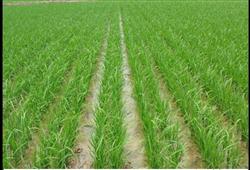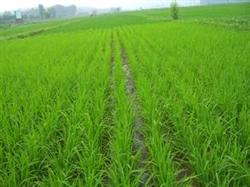Summary of dry cultivation and sparse planting of Rice

Rice dry cultivation and sparse planting is one of the agronomic measures popularization. the perennial rice cultivation area is 9315 mu and the per unit yield is low. With the continuous non-development and progress of science and technology, the yield has been significantly increased, especially since the promotion of wide and narrow row planting and dry cultivation and sparse planting, the effect is better, and farmers have been able to increase production and income. The technology of dry cultivation and sparse planting of rice is one of the key extension projects of agricultural technology during the Ninth five-year Plan period. Since the site meeting of dry cultivation and sparse planting in Zhaotong area was held in 1996, the area of Baihetan town has gradually increased and the per unit yield has increased obviously. By summing up the experience, we have adopted publicity to the group, training in advance, training to households, so that the technology can be spread to thousands of families. The Spring Festival is just over. We began the on-site demonstration operation and implemented the specific tasks to the village households. The two committees of each village took the lead in doing a good job in promotion and publicity and clearly defined the planting task. Baihetan Town completed a total of 9315 mu of rice dry cultivation and sparse planting, distributed in 16 villages and 4547 households in 111cooperatives, accounting for 101% of the task. At present, the dry cultivation and sparse planting of rice is growing well, it has been nine yellow and ten harvests, and farmers have obtained high yield. Now the promotion of this technology is summarized as follows: first, seed selection, we uniformly select Shanyou 63 and Gangyou 22, which have strong advantages, disease resistance and high yield, soak them in multi-Yin flexible or lime water for 1-2 days before sowing, and then sow seeds with clean water. Second, strictly select sites to cultivate strong seedlings of appropriate age 1. Select land, choose leeward to the sun of the neutral land or acid dry land to do seedling bed, it is best to choose vegetable land, potato land and so on. two。 Soil preparation and fertilization: make the bed flat, fine and evenly fertilized, mix with 10 kg of farm dry fertilizer and 0.15 kg of common calcium per square meter, open ditches to bury soil moisture, smooth soil moisture, and then sow and water after watering. 3. Sowing and covering soil with plastic film (1) sowing seeds sparsely, cultivating strong seedlings of suitable age, sowing seeds 0.08kg-0.1kg per square meter, sowing back and forth artificially, then covering fine soil 1cm, spraying soil with chemical herbicide butylammonium, 0.25g water to 0.15kg per square meter. (2) cover the film and uncover the film, cover the arch film immediately after covering the soil to prevent the seedlings from being ventilated. When 1.5-2.5 leaves are opened at both ends during the day, the cover is strict at night, and the seedlings are ventilated all day after three leaves. A week later, it is better to uncover the film in the morning when the sun is not coming out. Stop exposing the film at noon. Third, fertilization measures early application of medicine fertilizer, look at the seedling application, per mu application of farm fertilizer 1000-1500 kg, calcium fertilizer 25-50 kg, urea 10-15 kg, good application of middle-level fertilizer. According to the characteristics of seedling turning green, 15-20 kg of urea per mu was applied 5 days after planting, and 3-5 kg was added during the gestation period. Fourth, reasonable close planting: transplanting 15000-2000 clumps per mu, 1-2 seedlings per clump, one seedling per clump, and more than 200000 effective planting per mu. Fifth, strengthen scientific management and timely prevention and control of diseases and insect pests (1) Chemical weeding, 6 days after transplanting, spread the field evenly with 5 grams of fine soil and 25 kilograms of fine soil per mu to keep the shallow water layer for a week. (2) "prevention first, comprehensive control" to control diseases and insect pests in the lowest loss degree. The armyworm uses 20% to kill butylated EC 20-30 ml / mu. Bacterial blight was treated with 25% wettable powder 100-150g / mu, and borers were treated with 3% carbofuran granule 500g-5000 g exchange soil 3-5kg ditch or sprinkling. Sixth, to achieve timely harvest, "nine yellow ten harvest", the particles return to the warehouse. To sum up, dry cultivation and sparse planting has the advantages of saving species, saving seedling area, saving labor, saving fertilizer, enhanced stress resistance, developed plant roots, strong leaves, good elasticity and so on. Combined with the local reality, dry cultivation and sparse planting of rice has achieved good results.
- Prev

Field Management of dry raising Rice seedlings and transplanting in the Field
1. Fine field preparation, so that the field is flat and muddy, and an inch of water does not expose mud. 2. Fertilization principle: heavy application of base fertilizer and skillful application of spike and grain fertilizer. The amount of farm manure per mu is not less than 1500 kg. When raking the field, 70% of phosphorus, potash and nitrogen fertilizer are applied at one time, 20% of nitrogen fertilizer is used as tiller fertilizer, and 10% is used as panicle fertilizer (5 ml 10 days before heading). ...
- Next

Cultivation techniques of dry cultivation and dry cultivation of Rice
Dry cultivation means that when the seedling age of early rice is suitable for throwing and planting, under the condition of drought and lack of water in the field, herbicides are directly sprayed to control weeds, and then holes are burrowed with wooden sticks or ditches are opened with shovels, and then seedlings are transplanted and planted. Key points of cultivation techniques (1) Paddy field treatment: spraying herbicides before planting is optional.
Related
- The first cup of black tea in spring, the flavor and history of tea gardens in Kenya, Africa
- The computer can not only choose potatoes, but also grow tea rice. AI will grow winter oolong tea champion.
- It is not only the inflated tea bitten by insects, but also engraved with the four seasons tea in Beipu.
- The Oriental Beauty Tea Festival in Zhuxian County takes the stage at the weekend to experience the plus-size feast of oil tea.
- & quot; Oriental Beauty Tea & Exploration of Emei in Hsinchu, the hometown of quot;
- The new variety of strawberry "Tainong 1" dessert is the first choice with mellow aroma. Crimson gorgeous
- History of Tea in Taiwan: from Wild Inner Mountain to Export Tea Garden
- Two types of Taiwan Oriental Beauty Black Tea won the British three-Star Award for Childhood Tea Xiang Zhang Jiaqi changed from pilot to champion tea maker.
- Banana species and varieties: the planting history of Taiwan Xianren banana and dwarf banana is long, is banana disease resistant?
- Coffee planting Technology: Qianjie Coffee from Seedling to harvesting

